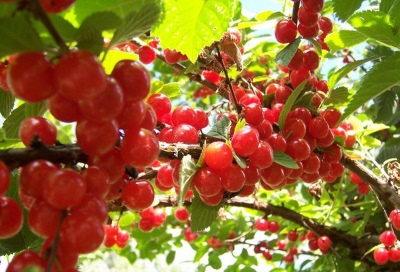
- Authors: V.P. Tsarenko, N.A. Tsarenko
- Appeared when crossing: Summer x Red sweet
- Year of approval: 1999
- Barrel type: bush
- Growth type: undersized
- Crown: broadly oval, spreading, medium thickening
- Escapes: red-brown, pubescent
- Leaves: small, elongated-oval, dark green, corrugated, slightly concave, covered with short hairs
- Flowers: saucer, medium, white
- Flowering and fruiting type: bouquet twigs and fruit twigs
Cherry Princess is not the most capricious plant (contrary to the name). But it is important to cultivate it correctly, to follow the key recommendations of the originators. It will also be interesting to find out what you can count on when growing such a crop.
Breeding history
The developers of the variety are breeders V.P. Tsarenko and N.A. Tsarenko. The name belongs to their surname, there is no monarchical reference in that. The varieties Krasnaya Sweet and Leto were taken as the basis for hybridization. Officially, the plant has been allowed to be used in private gardens since 1999. It is known that the development of the Princess was carried out in the Far East.
Description of the variety
This cherry is one of the felt varieties. It has a universal fruit purpose. The bushes are not too tall - they reach only 1.2 m. The crown, which is distinguished by its spreading character, resembles a wide oval in shape. Medium thickening is typical for it.
Other features:
- the direct nature of the growth of branches;
- light-colored lentils on the same branches;
- brown-gray scaly bark on branches;
- medium-sized leaves resembling an elongated oval;
- dark green color and pronounced corrugation of foliage;
- flowers are similar in shape to a saucer, painted in a white tone;
- 1 or 2 flowers are collected in inflorescences;
- the average life span is 17 years.
Fruit characteristics
The princess's drupes are rather large. Their size is on average 1.5x1.7x1.6 cm. Such a fruit will weigh from 3.6 to 4 grams.
Other nuances of these fruits:
- ovoid;
- slightly noticeable "beak";
- rich pink color;
- the bone cannot be separated from the soft part;
- the abdominal seam looks like a strip;
- the detachment of drupes is of a semi-dry type;
- beautiful, outwardly attractive appearance;
- shiny peel with pubescence of hairs.
Taste qualities
This variety has a sweet and sour taste. In general, it is perceived harmoniously. Delicious sweet and sour juice is extracted from the fruit. The fibrous dense pulp is juicy. The proportion of dry matter reaches 9.58%, the concentration of sugars is 8.2%, and the intake of acids is 0.67%. The tasting examination gave the fruit a score of 3.8 points.
Ripening and fruiting
The first crops can be harvested in 2-4 years of development. The Princess will bloom normally in the second decade of May. It is believed that this plant has an average ripening period. The collection of drupes is carried out approximately from 19 to 29 July. The fruits form at the same time, but weather conditions can greatly affect the development of the tree.

Yield
On average, 9.6 kg of cherries are grown on 1 bush. Much depends on the weather and on the literacy of agrotechnical measures.
Self-fertility and the need for pollinators
A princess cannot pollinate herself. To grow it, you need to plant plants with identical flowering times.
Landing
For this plant, high soil fertility is very important. It is recommended to choose sunny areas with a decent level of drainage.Landing takes place according to the classic scheme. Cherries can be propagated by green cuttings.
You can grow such a cherry:
- in the Far East;
- in Siberia;
- in the Urals;
- in Central Russia;
- in the Volga region;
- in the Volgo-Vyatka region.


Growing and care
Resistance to dry periods allows you to minimize the watering of the Princess. It is possible to plant it both in spring and autumn. It is necessary to take into account the very early vegetation of felt trees, because of which it is inappropriate to delay planting. However, when purchasing seedlings with closed roots, there will be no such strict restrictions. Before planting, the soil should be fertilized:
- 30 kg of organic matter (but fresh manure will not work);
- 0.8 kg of lime (if the earth is acidic);
- 0.06 kg of phosphate fertilizers;
- 0.03 kg of potash mixtures.
The roots are in the surface layer, which must be taken into account when determining the size of the planting pit and when loosening. Each seedling is watered using 10-20 liters of water. The branches in the process of planting are shortened by about 1/3. In the course of annual pruning, 10 to 12 of the strongest shoots are left. Some of the shoots are cut from the side “into a ring” in order to activate the formation of new material.
With rejuvenating pruning, the centers of the crowns and skeletal branches along the edges are cut. This procedure is carried out every 5 years. Potassium-phosphorus mixtures to prepare for winter should be applied in October. After the end of the leaf fall, water-charging irrigation is carried out. Rodent protection is very important.


Requirements for soil and climatic conditions
The official description emphasizes the solid resistance to cold and hot weather. Waterlogging is completely unacceptable. You need to choose quality land with good structure.
































































